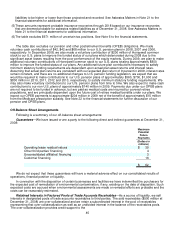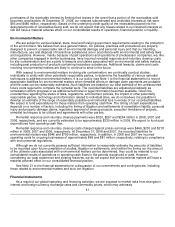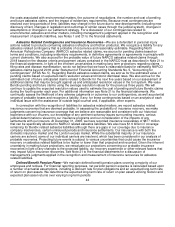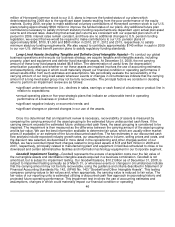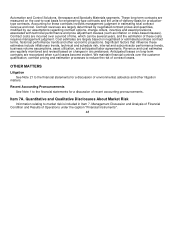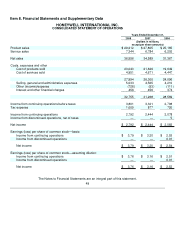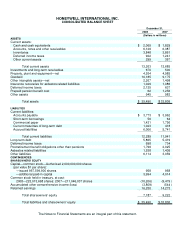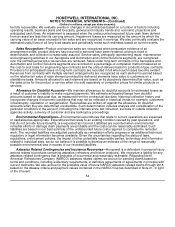Honeywell 2008 Annual Report Download - page 66
Download and view the complete annual report
Please find page 66 of the 2008 Honeywell annual report below. You can navigate through the pages in the report by either clicking on the pages listed below, or by using the keyword search tool below to find specific information within the annual report.
performance if actual results differ from such estimates and assumptions. We completed our annual impairment
test as of March 31, 2008 and determined that there was no impairment as of that date.
Income Taxes—Deferred tax assets and liabilities are determined based on the difference between the
financial statements and tax basis of assets and liabilities using enacted tax rates in effect for the year in which
the differences are expected to reverse. Our provision for income taxes is based on domestic and international
statutory income tax rates and tax planning opportunities in the jurisdictions in which we operate. Significant
judgment is required in determining income tax provisions as well as deferred tax asset and liability balances,
including the estimation of valuation allowances and the evaluation of tax positions.
As of December 31, 2008, we recognized a net deferred tax asset of $2,762 million, less a valuation
allowance of $445 million. Net deferred tax assets are primarily comprised of net deductible temporary
differences, net operating loss carryforwards and tax credit carryforwards that are available to reduce taxable
income in future periods. The determination of the amount of valuation allowance to be provided on recorded
deferred tax assets involves estimates regarding (1) the timing and amount of the reversal of taxable temporary
differences, (2) expected future taxable income, and (3) the impact of tax planning strategies. A valuation
allowance is required when it is more likely than not that all or a portion of a deferred tax asset will not be
realized. In assessing the need for a valuation allowance, we consider all available positive and negative
evidence, including past operating results, projections of future taxable income and the feasibility of ongoing tax
planning strategies. The projections of future taxable income include a number of estimates and assumptions
regarding our volume, pricing and costs. Additionally, valuation allowances related to deferred tax assets can be
impacted by changes to tax laws.
Our net deferred tax asset of $2,762 million is comprised of $2,267 million related to U.S. operations and
$495 million related to non-U.S. operations. The U.S. net deferred tax asset of $2,267 million is comprised of net
deductible temporary differences, tax credit carryforwards and state tax net operating losses which we believe
will more likely than not be realized through the generation of future taxable income in the U.S. and tax planning
strategies. We maintain a valuation allowance of $6 million against such asset related to state net operating
losses. The non-U.S. net deferred tax asset of $495 million is comprised principally of net operating and capital
loss carryforwards, mainly in Germany, France and the United Kingdom. We maintain a valuation allowance of
$439 million against these deferred tax assets reflecting our historical experience and lower expectations of
taxable income over the applicable carryforward periods. As more fully described in Note 6 to the financial
statements, our valuation allowance decreased by $45 million and $26 million in 2008 and 2007, respectively,
and increased by $39 in 2006. In the event we determine that we will not be able to realize our net deferred tax
assets in the future, we will reduce such amounts through a charge to income in the period such determination is
made. Conversely, if we determine that we will be able to realize net deferred tax assets in excess of the carrying
amounts, we will decrease the recorded valuation allowance through a credit to income in the period that such
determination is made.
Significant judgment is required in determining income tax provisions under Statement of Financial
Accounting Standards No. 109 "Accounting for Income Taxes" (SFAS No. 109) and in evaluating tax positions.
We establish additional provisions for income taxes when, despite the belief that tax positions are fully
supportable, there remain certain positions that do not meet the minimum probability threshold, as defined by
FASB Interpretation ("FIN") No. 48, "Accounting for Uncertainty in Income Taxes—An Interpretation of FASB
Statement 109" ("FIN 48"), which is a tax position that is more likely than not to be sustained upon examination
by the applicable taxing authority. In the normal course of business, the Company and its subsidiaries are
examined by various Federal, State and foreign tax authorities. We regularly assess the potential outcomes of
these examinations and any future examinations for the current or prior years in determining the adequacy of our
provision for income taxes. We continually assess the likelihood and amount of potential adjustments and adjust
the income tax provision, the current tax liability and deferred taxes in the period in which the facts that give rise
to a revision become known.
Sales Recognition on Long-Term Contracts—In 2008, we recognized approximately 13 percent of our
total net sales using the percentage-of-completion method for long-term contracts in our
47



